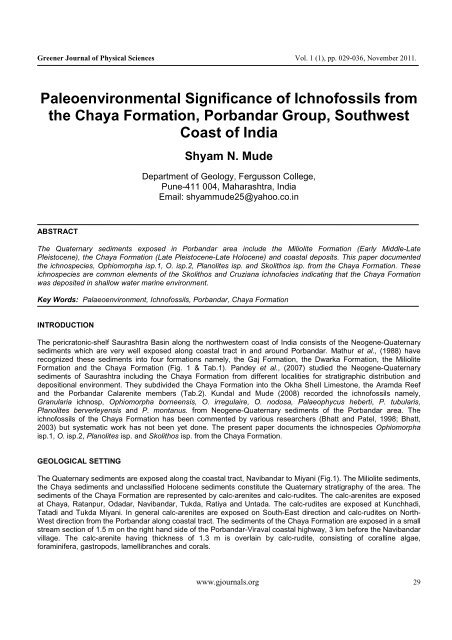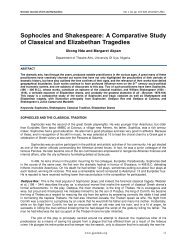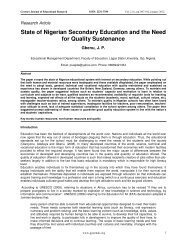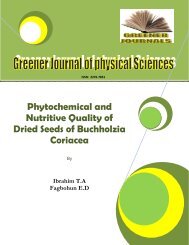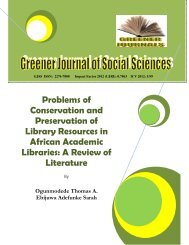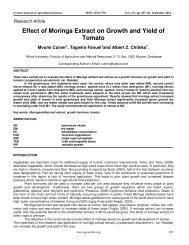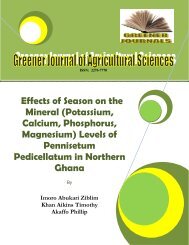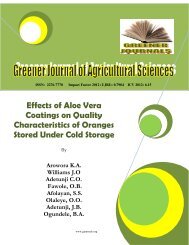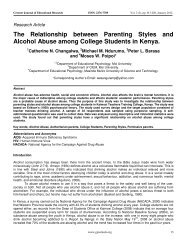Reprint (PDF) - Greener Journals
Reprint (PDF) - Greener Journals
Reprint (PDF) - Greener Journals
Create successful ePaper yourself
Turn your PDF publications into a flip-book with our unique Google optimized e-Paper software.
<strong>Greener</strong> Journal of Physical Sciences Vol. 1 (1), pp. 029-036, November 2011.<br />
Paleoenvironmental Significance of Ichnofossils from<br />
the Chaya Formation, Porbandar Group, Southwest<br />
Coast of India<br />
Shyam N. Mude<br />
Department of Geology, Fergusson College,<br />
Pune-411 004, Maharashtra, India<br />
Email: shyammude25@yahoo.co.in<br />
ABSTRACT<br />
The Quaternary sediments exposed in Porbandar area include the Miliolite Formation (Early Middle-Late<br />
Pleistocene), the Chaya Formation (Late Pleistocene-Late Holocene) and coastal deposits. This paper documented<br />
the ichnospecies, Ophiomorpha isp.1, O. isp.2, Planolites isp. and Skolithos isp. from the Chaya Formation. These<br />
ichnospecies are common elements of the Skolithos and Cruziana ichnofacies indicating that the Chaya Formation<br />
was deposited in shallow water marine environment.<br />
Key Words: Palaeoenvironment, Ichnofossils, Porbandar, Chaya Formation<br />
INTRODUCTION<br />
The pericratonic-shelf Saurashtra Basin along the northwestern coast of India consists of the Neogene-Quaternary<br />
sediments which are very well exposed along coastal tract in and around Porbandar. Mathur et al., (1988) have<br />
recognized these sediments into four formations namely, the Gaj Formation, the Dwarka Formation, the Miliolite<br />
Formation and the Chaya Formation (Fig. 1 & Tab.1). Pandey et al., (2007) studied the Neogene-Quaternary<br />
sediments of Saurashtra including the Chaya Formation from different localities for stratigraphic distribution and<br />
depositional environment. They subdivided the Chaya Formation into the Okha Shell Limestone, the Aramda Reef<br />
and the Porbandar Calarenite members (Tab.2). Kundal and Mude (2008) recorded the ichnofossils namely,<br />
Granularia ichnosp, Ophiomorpha borneensis, O. irregulaire, O. nodosa, Palaeophycus heberti, P. tubularis,<br />
Planolites berverleyensis and P. montanus. from Neogene-Quaternary sediments of the Porbandar area. The<br />
ichnofossils of the Chaya Formation has been commented by various researchers (Bhatt and Patel, 1998; Bhatt,<br />
2003) but systematic work has not been yet done. The present paper documents the ichnospecies Ophiomorpha<br />
isp.1, O. isp.2, Planolites isp. and Skolithos isp. from the Chaya Formation.<br />
GEOLOGICAL SETTING<br />
The Quaternary sediments are exposed along the coastal tract, Navibandar to Miyani (Fig.1). The Miliolite sediments,<br />
the Chaya sediments and unclassified Holocene sediments constitute the Quaternary stratigraphy of the area. The<br />
sediments of the Chaya Formation are represented by calc-arenites and calc-rudites. The calc-arenites are exposed<br />
at Chaya, Ratanpur, Odadar, Navibandar, Tukda, Ratiya and Untada. The calc-rudites are exposed at Kunchhadi,<br />
Tatadi and Tukda Miyani. In general calc-arenites are exposed on South-East direction and calc-rudites on North-<br />
West direction from the Porbandar along coastal tract. The sediments of the Chaya Formation are exposed in a small<br />
stream section of 1.5 m on the right hand side of the Porbandar-Viraval coastal highway, 3 km before the Navibandar<br />
village. The calc-arenite having thickness of 1.3 m is overlain by calc-rudite, consisting of coralline algae,<br />
foraminifera, gastropods, lamellibranches and corals.<br />
www.gjournals.org 29
<strong>Greener</strong> Journal of Physical Sciences Vol. 1 (1), pp. 029-036, November 2011.<br />
Table-1: Classification of Quaternary sequence of Saurashtra, Porbandar area,<br />
( modified after Mathur et al., 1988, Bhatt, 2000 & 2003)<br />
Stratigraphic Unit Lithology Age<br />
Freshwater alluvium (sands,clays) coastal<br />
deposits<br />
ALLUVIUM AND COASTAL (Lime mud; rann clays with carbonaceous<br />
DEPOSITS material /marine shells; unconsolidated Holocene<br />
calcareous sands)<br />
PORBANDAR GROUP<br />
Chaya Formation<br />
Semiconsolidated to consolidated limestone Late Pleistocene<br />
Porbandar Calcarenite (calcirudites); shell limestone;coral reef , to Late Holocene<br />
Member<br />
oyster beds and calcarenites with megafossils<br />
Miliolite Formation<br />
Adatiana Member Pelletoid limestone (calcarenites) Middle to Late<br />
Pleistocene<br />
Dhobaliya Talav Alternating sequence of pelletoid limestone Early Middle<br />
Member and fine-grained limestone (micrites) Pleistocene<br />
Dwarka Formation / Gaj Formation / Deccan Trap<br />
Table – 2: Classification of Chaya Formation (after Pandey et al., 2007)<br />
Stratigraphic<br />
Lithology<br />
Holocene sediments<br />
(Unconformity)<br />
Chaya Formation<br />
Porbandar Calcarenite Member: Semiconsolidated and consolidated calcarenite<br />
with megafossils<br />
Aramda Reef Member:<br />
Coral-algal reef, coral bafflestone with micro<br />
and mega –fossils<br />
Okha Shell Limestone Member: Cross-bedded pack to rudstone, bioturbated shell<br />
limestone with mega- fossils<br />
(Unconformity)<br />
Miliolite Formation<br />
www.gjournals.org 30
<strong>Greener</strong> Journal of Physical Sciences Vol. 1 (1), pp. 029-036, November 2011.<br />
SYSTEMATICS OF ICHNOFOSSILS<br />
This study of palichnology follows the systematics of the Treatise on Invertebrate Paleontology, (Haentschel, 1975)<br />
and the morphological classification of Simpson (1975), ethological classification of Seilacher (1964) and ichnofacies<br />
classification of Seilacher (1964, 1967) are adopted..<br />
Ichnogenus: Ophiomorpha Lundgren, 1891<br />
Ichnospecies: Ophiomorpha isp.1<br />
(Pl. I, figs.1,2)<br />
Material: Specimens Nos- IF- 11, 13, 17<br />
Dimensions: Diameter of burrow-50-55mm<br />
Remarks: Burrows are vertical and unbranched. Walls of burrows consist of pellets of varying shape. Other<br />
features are not preserved as they have been obliterated by weathering. Kundal and Dharashivkar (2006) reported<br />
Ophiomorpha borneensis Keij, Ophiomorpha irregulaire Frey, Howard and Pryor and Ophiomorpha nodosa Lundgren<br />
from the Shankhodhar Sand Clay Member (Dwarka Formation) at the Dingeshwar Mahadev cliff. Ophiomorpha<br />
nodosa Lundgren has been reported by Chiplonkar and Ghare (1975) from the Bagh Group and Kundal et al., (2005)<br />
documented it from the Babaguru Formation at Bhilod village, Broach district, Gujarat. The present specimens do not<br />
show much similarities with above three species of Ophiomorpha, thus on the basis of shape and present pellets,<br />
the present specimens are described as Ophiomorpha isp.1. They are interpreted morphologically as shaft and<br />
ethologically as domichnia.<br />
Horizon and Locality: Calc-arenite/ sandy limestone of the Chaya Formation exposed along a small stream<br />
section, 3 km before the Navibandar.<br />
Ichnospecies: Ophiomorpha isp 2.<br />
(Pl. I, fig.5)<br />
Material: Specimen No- IF- 20<br />
Dimensions: Diameter of burrow- 20-25mm<br />
Remarks: Burrow is vertical and U-shaped. A wall of burrow consists of pellets. Other features are not<br />
preserved due to weathering. The present specimens do not show much similarities with Ophiomorpha borneensis<br />
Keij, Ophiomorpha irregulaire Frey, Howard and Pryor and Ophiomorpha nodosa Lundgren, thus on the basis of U-<br />
shape and present pellets, the present specimen is described under Ophiomorpha isp.2. They are interpreted<br />
morphologically as shaft and ethologically as domichnia.<br />
Horizon and Locality: Calc-arenite/ sandy limestone of the Chaya Formation exposed along a small stream section, 3<br />
km before the Navibandar.<br />
Ichnogenus: Planolites Nicholson, 1873<br />
Ichnospecies : Planolites isp.<br />
(Pl. I, figs. 3, 6, 8, 9)<br />
Material: Specimens Nos-IF- 10, 12, 13, 14, 16, 18<br />
Dimensions: Diameter of burrow-10-20mm<br />
Remarks: Burrows are cylindrical in shape, unbranched, straight to gently curved and undulose. They are<br />
horizontal to the bedding plane. Some burrows are preserved as positive epirelief and some are preserved as<br />
negative epirelief. The colour and material of the burrows are different than that of the host rock. Badve (1987) and<br />
Kundal & Sanganwar (1998) documented Paleophyus tubularis Hall (Pemberton and Frey, 1982), from the Bagh<br />
Group of Madhya Pradesh. Kundal et al., (2005) documented it from the Babaguru Formation at Bhilod village,<br />
Broach district, Gujarat, Kundal and Dharashivkar (2006) recorded this species from the Positra Limestone Member<br />
of Dwarka Formation. Kundal and Mude (2008) documented it from the Adatiana Member of the Miliolite Formation of<br />
the Porbandar area.<br />
Borkar and Kulkarni (1992) and Kundal and Sanganwar (1998, 2000) recorded Planolites beverleyensis<br />
(Billings) from Wadhawan Formation of Gujarat and Bagh Group of Madhya Pradesh, respectively. Kundal et al.,<br />
(2005) documented it from Babaguru Formation at Bhilod village, Broach district, Gujarat. Kundal and Dharashivkar<br />
(2006) recorded this species from the Shankhodhar Sand-Clay Member, Dwarka Formation. Kundal and Mude<br />
(2008) documented it from the Adatiana Member of the Miliolite Formation and Dwarka Formation of the Porbandar<br />
area.<br />
Many researchers ( e.g., Badve and Ghare 1978, 1980; Sanganwar and Kundal 1997; Kundal and<br />
Sanganwar 1998, 2000) reported Planolites montanus Richter from the Bagh Group of Madhya Pradesh while<br />
Chiplonkar and Ghare (1979) documented from the Trichinopoly Group, Tamil Nadu. Kundal et al., (2005)<br />
www.gjournals.org 31
<strong>Greener</strong> Journal of Physical Sciences Vol. 1 (1), pp. 029-036, November 2011.<br />
documented it from the Babaguru Formation at Bhilod village, Broach district, Gujarat. Kundal and Dharashivkar<br />
(2006) reported this ichnospecies from the Shankhodhar Sand Clay Member (Dwarka Formation) at the Dingeshwar<br />
Mahadev cliff. Kundal and Mude (2008) documented it from the Adatiana Member of the Miliolite Formation of the<br />
Porbandar area. The present burrows described here do not show many similarities with the above mentioned<br />
species, thus, as the burrows are cylindrical, unbranched and straight to gently curved and lack of other details, they<br />
are described as Planolites isp. and kept under open nomenclature. They are interpreted morphologically as tunnel<br />
and ethologically as fodinichnia.<br />
Horizon and Locality: Calc-arenite/ sandy limestone of the Chaya Formation exposed along a small stream<br />
section, 3 km before the Navibandar.<br />
Ichnogenus: Skolithos Haldeman, 1830<br />
Ichnospecies: Skolithos isp.<br />
(Pl. I, figs.1, 4, 7)<br />
Material: Specimens Nos- If- 21, 22, 24, 25, 26, 27, 28<br />
Dimensions: Diameter of burrow-12-30 mm.<br />
Remarks: Burrows are cylindrical, unbranched, and disposed perpendicaular to the bedding plane. Surface<br />
annulations or any other surfacial notable features are not seen. Since the burrows are perpendicular to the bedding<br />
plane, the surface annulations are not seen, therefore the present burrows are described as Skolithos isp. and kept<br />
in open nomenclature( Haentzschel, 1975 ). They are interpreted morphologically as shaft and ethologically as<br />
domichnia.<br />
Horizon and Locality: Calc-arenite/ sandy limestone of the Chaya Formation exposed along a small stream<br />
section, 3 km before the Navibandar.<br />
CONCLUSIONS<br />
The Chaya Formation was exclusively studied for ichnofossils. Four ichnospecies, Ophiomorpha isp.1, O. isp. 2,<br />
Planolites isp. and Skolithos isp. have been identified and recorded from the Chaya Formation. Ophiomorpha, is<br />
traditionally used as environmental indicators among trace fossils for paleoenvironmental interpretation. In the<br />
present day coastal area or in beach environment, Callianassa (now Callichiurus) major is the best-known modern<br />
analog for the Ophiomorpha- tracemaker. The typical abundance of burrows of Callianassa (now Callichiurus) major<br />
in beaches of the southeastern United States is well known today (Weimer and Hoyt, 1964), the beaches can be<br />
zoned on the basis of relative abundance of the burrows (Frey and Mayor, 1971, Pryor, 1975). In general,<br />
Ophiomorpha shafts predominate in higher energy environments and Ophiomorpha boxworks and mazes in lower<br />
energy environments. (Frey, 1975). The sediments of the Chaya Formation consist of moderate to coarser grains<br />
with abundant bioclast. The sedimentological study of these sediments and the ichnospecies from the Chaya<br />
Formation suggest Skolithos and Cruziana ichnofacies indicating that the Chaya Formation was deposited in shallow<br />
water marine conditions. The present study revels that the Chaya Formation was deposited in near-shore to shallow<br />
marine environment.<br />
ACKNOWLEDGEMENTS<br />
The author is thankful to University Grants Commission, Western Region, Pune-411007 for financial support for the<br />
present work from Minor Research Project (F.No. 47-020/07,WRO). The author expresses his hearty thanks to the<br />
reviewers for their constructive comments to improve the quality of paper, especially to Paula Camboim Dentzien-<br />
Dias of Brasil. The authors are thankful to Head, Department of Geology, Fergusson College, Pune-04 for necessary<br />
help rendered during this work.<br />
REFERENCES<br />
Badve, R. M.(1987). A reassessment of Stratigraphy of Bagh Beds, Barwah area,<br />
Madhya Pradesh, with description of trace fossils. Jour. Geol. Soc. India, 30:106-120.<br />
Badve, R. M. and Ghare, M. A. (1978). Jurassic ichnofauna of Kutch-I. Biovigyanam,<br />
India, 4: 125-140.<br />
www.gjournals.org 32
<strong>Greener</strong> Journal of Physical Sciences Vol. 1 (1), pp. 029-036, November 2011.<br />
Badve, R. M. and Ghare, M. A. (1980). Ichnofauna of Bagh Beds from Deva river<br />
valley, south of Narmada. Biovigyanam, India , 6: 121-130.<br />
Bhatt, N. (2000). Lithostratigraphy of Neogene-Quaternary deposits of Dwarka-Okha<br />
area, Gujarat. Jour. Geol. Soc. India, 55: 139-148.<br />
Bhatt, N. (2003).The Late Quaternary bioclastic carbonate deposits of Saurashtra<br />
and Kachchh, Gujarat, western India: A review. Proc. Indian Nat.<br />
Sci. Acad., 69A (2): 137-150.<br />
Bhatt, N. and Patel M. P. S. (1998). Bioclactic shore deposits: indicators of Late<br />
Quaternary high sea in Saurashtra, Western India. Jour. Geol. Soc. India,<br />
52:537-542.<br />
Borkar, V. D. and Kulkarni, K. G. (1992). On the occurrence of Planolites Nicholson<br />
from the Bhaduka Limestone of the Wadhwan Formation (Cretaceous),<br />
Kathiawar, Gujarat. Jour. Geol. Soc. India, 40: 468-473.<br />
Chiplonkar, G. M. and Ghare, M. A. (1975). Some additional trace fossils from the<br />
Bagh Beds. Bull. Ind. Geol. Asso. 8 (1): 71-84.<br />
Chiplonkar, G. M. and Ghare, M. A. (1979). Trace fossils from Upper Creataceous<br />
rocks of Trichinopoly district, Tamil Nadu. Geol. Surv. India, Misc. Pub.<br />
45: 101-109.<br />
Frey, R. W. 1975. The realm of ichnology, its strengths and limitations ,p. 13-38. In :<br />
The study of Trace Fossils. (Ed. R. W.Frey),Springer-verlag, New York,<br />
Frey, R. W. and Mayor, T. V. (1971). Decapod burrows in Holocene Barrier Island<br />
beaches and washover fans, Georgia, Senckenberg, Marit., 3: 53-77.<br />
Haentzschel, W. (1975). Trace fossils and Problematica, 2 nd edition. In: Treatise on<br />
Invertebrate Palaeontology, Pt. W. Misc. Suppl. Geol. Soc. America, Inc. and<br />
Univ. Kanasas, Boulder Colorado and Lawrence Kansas, pp. 269.<br />
Kundal, P. and Dharashivkar, A. P. (2006) . Ichnofossils from the Neogene and<br />
Quaternary deposits of Dwarka-Okha area, Jamnagar district, Gujarat, India.<br />
Jour. Geol Soc. India, 68: 299-315.<br />
Kundal, P. and Sanganwar, B. N. (1998). Stratigraphy and Palichnology of Nimar<br />
Sandstone, Bagh Beds of Jobat area, Jhabua district, M. P. Jour. Geol.<br />
Soc. India, 51 (5): 619-634.<br />
Kundal, P. and Sanganwar, B. N. (2000). Ichnofossils from Nimar Sandstone<br />
Formation, Bagh Group of Manawar area, Dhar disteict, Madhya Prasdesh.<br />
Mem. Geol.Soc. India. 46: 229-243.<br />
Kundal, P. K. and Mude, S. N. (2008). Ichnofossils from Neogene-Quaternary<br />
Sediments of Porbandar Area, Saurashtra, Gujarat, India. Jour.<br />
Palaeont. Soc. India , 53(2) : 207-214 .<br />
Kundal, P. Mude, S. N. and Humane S. (2005). Ichnofossils from Late Eocene to<br />
Early Miocene of Narmada block of Cambay Basin Gujarat, India. Jour. Paleo.<br />
Soc. India , GJ V. 50(2): 177-182.<br />
www.gjournals.org 33
<strong>Greener</strong> Journal of Physical Sciences Vol. 1 (1), pp. 029-036, November 2011.<br />
Mathur, U. B., Verma, K. K. and Mehra, S. (1988). Tertiary- Quaternary stratigraphy<br />
of Porbandar area, southern Saurashtra, Gujarat. Rec. Geol. Surv. India ,<br />
11(2): 333-345.<br />
Pandey, D. K., Bahadur, T. and Mathur U. B. (2007). Stratigraphic distribution and<br />
depositional environment of the Chaya Formation along the Northwestern<br />
coast of Saurashtra peninsula, Western India. Jour. Geol. Soc. India,<br />
69: 1215-1230.<br />
Pemberton , R. K. and Frey, R. W. (1982). Trace fossils nomenclature and Planolites<br />
Palaeophycus dilemma. Paleontology, 56 (2): 416-439.<br />
Pryor, W. A. (1975). Biogenic sedimentation and alternation of argillaceous sediments<br />
in the shallow marine environments. Bull. Geol. Soc. America,<br />
86: 1244-1254.<br />
Sanganwar, B. N. and Kundal, P. (1997). Ichnofossils from Nimar Sandstone<br />
Formation, Bagh Group of Barwah area, Khargaon district, M. P. Gond.<br />
Geol. Magz. 12 (12): 12-33.<br />
Seilacher, A.(1964). Biogenic sedimentary structures. In Imbrie, J. and Newell, N. D.,<br />
(Ed), Approaches to palaeoecology. John Willey and Sons, New York, pp. 246-<br />
316.<br />
Seilacher, A. (1967). Bathymetry of trace fossils. Marine Geology, 5: 413-428.<br />
Simpson, S. (1975). Classification of trace fossils, p. 39-54. In : The study of Trace<br />
Fossils. (Ed. Fery, R. W.) Springer Verlag, Berlin.<br />
Weimer, R. J. and Hoyt, J. H. (1964).Burrows of Callianassa major Say,<br />
geologic indicator of littoral and shallow neritic environment. Jour.<br />
Palaeont., 38: 761-767.<br />
EXPLANATION OF FIGURE-1<br />
A) Location Map of India (After Google Map),<br />
B) Location Map of Gujarat (After Google Map) and<br />
C) Geological Map of the Study area ( After Mathur et al, 1988)<br />
EXPLANATION OF PLATE<br />
1. Ophiomorpha isp.1, Specimen No. IF-17, burrow perpendicular to the bedding plane.<br />
2. Ophiomorpha isp.1, Specimen No. IF-11, burrow perpendicular to the bedding plane.<br />
3. Planolites isp., Specimen No. IF-12, burrows horizontal to the bedding plane.<br />
4. Skolithos isp.., Specimen No. IF-28, burrow perpendicular to the bedding plane.<br />
5. Ophiomorpha isp.2, Specimen No. IF-20, burrow perpendicular to the bedding plane.<br />
6. Planolites isp., Specimen No. IF-18, burrows horizontal to the bedding plane.<br />
7. Skolithos isp., Specimen No. IF-21, burrow perpendicular to the bedding plane.<br />
8. Planolites isp., Specimen No. IF-19, burrows horizontal to the bedding plane.<br />
9. Planolites isp., Specimen No. IF-13, burrows horizontal to the bedding plane.<br />
www.gjournals.org 34
<strong>Greener</strong> Journal of Physical Sciences Vol. 1 (1), pp. 029-036, November 2011.<br />
www.gjournals.org 35
<strong>Greener</strong> Journal of Physical Sciences Vol. 1 (1), pp. 029-036, November 2011.<br />
www.gjournals.org 36


